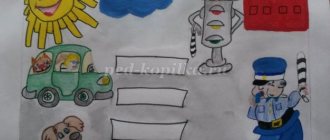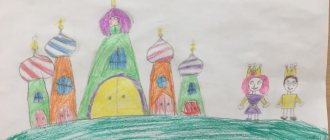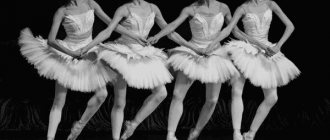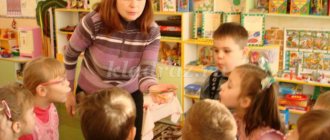Middle group. Junior preschool age. Children 4 - 5 years old
Summary of an open lesson on speech development in the middle group “Sounds [m] - [m']” Purpose: Introducing the sounds “M - Mb”
Objectives: Learn to pronounce the sounds
“M - M”
. Teach children to distinguish these sounds intonationally in syllables, words, phrases; Develop phonemic awareness when working with words that differ in pronunciation by one sound; Work on a generalized...
Summary of an open lesson on FEMP in the middle group "Journey to the Land of Numbers" Summary of an open lesson on FEMP in the middle group on the topic "Journey to the Land of Numbers"
conducted by teacher O. A. Baranova. Topic:
“Journey to the land of numbers
. Goal: to consolidate children’s knowledge of quantitative and ordinal counting, names of geometric shapes, time...
Summary of the training session “Getting Acquainted”
(For preschoolers 4-5 years old)
Description . This lesson represents the beginning of a cycle of lessons in the developmental program. It can be used in the introductory block of developmental programs, allowing you to orient children to classes in a playful way, accepting work rules and effectively realizing other goals.
The goal is to form a training group of preschoolers aged 4-5 years for the effective subsequent implementation of the developmental program.
Tasks:
- arrange for group members to meet a psychologist;
- organize conditions for the adoption of group practice rules;
- reduce the emotional stress of preschoolers;
- create a favorable psychological atmosphere in the group;
- create a situation of success for preschoolers;
- introduction to the development program.
Equipment: butterfly toy, pictures of butterflies (3-4 pictures), musical accompaniment - P.I. Tchaikovsky “Polka”, music player, toy camera, “general photo” coloring book, colored pencils.
The lesson is aimed at 5-7 preschoolers aged 4-5 years.
Expected result : the initial stage of the formation of a training group of preschoolers with ideas about the rules of behavior in the classroom and a positive attitude towards them.
Progress of the lesson:
1. Greeting . The goal is motivation for activity, initial acquaintance with the rules in the classroom. The form is conversation.
Description: A psychologist comes to the group, gathers children around him and invites them to go with him on a trip to one of his friends. At the same time, he warns that he will take the guys on a trip if they promise to all go together (not run away), speak in turns, walk together (help each other, don’t fight, don’t offend each other) and as soon as they hear three claps, there should be silence . After which he invites everyone to get on the train and go for a visit.
2. Steam locomotive . The goal is to create an emotional mood for the lesson. Form is a game.
Description: the psychologist invites the children to get on a train and hit the road. At the same time, he suggests singing a song along the way: The locomotive is traveling, the locomotive is traveling, it took its friends to visit. Two pipes, a hundred wheels, he took his friends to visit. He brought two pipes and a hundred wheels to visit his friends. Tu-tu-tu… .
3. Meet the butterfly. The goal is to develop self-presentation skills and maintain interest in activities. Form – conversation, exercise.
Description: a psychologist with children drives up on a “steam locomotive” to a toy – a butterfly – lying on the table. The psychologist draws attention to how beautiful his familiar butterfly is and invites the children to sit on the carpet around the toy. “Butterfly” welcomes her guests and tells them that her name is butterfly Zoya and she loves to fly and relax on flowers. He asks what each child’s name is and what he likes to do, and shakes everyone’s hand.
4. Flight of butterflies . The goal is to reduce muscle tension, master the rule of three claps and silence, increase the emotional background, and create conditions for self-expression. Form is an active game.
Description: “butterfly” invites the children to play her favorite game and imagine that they have become butterflies and are flying and dancing beautifully over the field. But as soon as three claps sound, the butterflies should immediately sit on the flowers and silence should fall. The game is played with musical accompaniment - P.I. Tchaikovsky "Polka". The game is played in 3-4 steps.
5. Blitz survey. The goal is to create a situation of success. The form is conversation.
Description: “Butterfly” invites everyone to sit down, praises them for their beautiful dancing and attentiveness. She says that she also has friends, they also like to play and begins to show photographs of her friends (pictures of butterflies). The psychologist asks the children what color this butterfly is, what size, what size, what shape the wings of the butterfly resemble.
6. General photo. The goal is to experience comfort in situations of interaction with peers. The form is joint drawing.
Description: a psychologist asks a butterfly why she was upset. “Butterfly” replies that she has so much fun playing with the guys, they are so friendly and cheerful, and without them she will be sad. The psychologist invites the children to take a photo together with a butterfly as a souvenir using a magic camera, so that she would not be so sad without them. The children stand near the butterfly, the psychologist takes a photograph of them and shows them a coloring drawing of children with a butterfly. And he invites the children to color it so that the photo of the butterfly remains beautiful, and invites them to the table. At the end of the work, the psychologist and the children present the resulting “group photo.”
7. Farewell. The goal is to accept the rules of the lesson and develop reflection. The form is conversation.
Description: “Butterfly” praises the guys that they know so much and how friendly they played with her. He points out that this is because the guys followed the rules: everyone played together (don’t run away), they spoke in turns, helped each other, and after three claps there was silence.. He asks the guys if they remember what they played with the butterfly. Invites them to visit next time, says goodbye to everyone
8. Steam locomotive . The goal is to create an emotional conclusion to the lesson. Form is a game.
Description: the psychologist invites the children to get on a train and hit the road in a group. And sing a song along the way: The locomotive is traveling, traveling, he took his friends to the group. Two pipes, a hundred wheels, he took his friends to the group. He brought two pipes and a hundred wheels to the group. Tu-tu-tu… . In the group, the psychologist says goodbye to the guys
Used sources:
The text of the song by S. Ernesaks, V. Tatarinov “a steam locomotive is traveling, two labors and a hundred wheels.”
Open classes. Notes - Open lesson in the middle group “Autumn leaves on the path”
Publication “Open lesson in the middle group “Autumn leaves on ...” Summary of a lesson on relief modeling from salt dough: “Autumn leaves on the paths” Goal: To develop in children an aesthetic culture for the world around them and creative self-realization. Objectives: 1. Introduce children to the technique of relief modeling and the properties of salt dough. Pin...
Outline of an open lesson in the middle group “Basics of safe behavior on the roads”
Outline of an open lesson in the middle group on the topic: “Basics of safe behavior on the roads” Goal: Continue to familiarize children with the rules of the road, teach them to practically apply them in various situations. Objectives: • consolidate initial ideas about...
Summary of an open lesson on artistic creativity in the middle group on the work of K. Chukovsky "Confusion" Summary of an open lesson on artistic creativity in the middle group on the work of K. Chukovsky "Confusion" Form of collective work: frontal - this is a collective work, which is a combination of individual drawings children made with…
Open lesson in mathematics “Skills of forward and backward counting to 10” in the middle group Summary of a lesson in mathematics in the middle group. Goal: to consolidate the skills of counting forward and backward to 10, the ability to navigate on the plane of a sheet of paper, to consolidate knowledge about flat and three-dimensional geometric figures, to select objects similar to three-dimensional geometric shapes. figures...
Games for dating children and teenagers
Chairs
The guys stand on chairs arranged in a circle. The leader's command is the start to the beginning of the game. Players need to line up in alphabetical order of their names, moving from chair to chair without touching the floor with their feet.
Guess right away
The children sitting in a circle are given a ball. The first player must throw it to any player and say the initial syllable of their name. The player to whom the ball was thrown tries to guess the second syllable of the name. If the answer is correct, the player who threw the ball says his name; if the answer is incorrect, he answers “No” and waits for one of the other participants to guess his name. The game ends when all the guys' names are named.
Find the namesake
Participants in the game need to find their namesakes in order to unite with them into one group. The host gives the signal to start the game, and the guys begin to shout out their names. Victory goes to the most active and fastest.
star Rain
Each of the guys receives a paper star. They must write their name on it. After this, the presenter goes around everyone with a box in his hands. Everyone throws a star into the box and says their name out loud. After all the stars have been collected, the guys take turns pulling them out of the box. Having taken out the star, the player reads the name written on it and gives it to the owner.
Girls-boys
Girls sit in one row, and boys sit in the row opposite. The girls take turns calling the men's names. If there is a boy with that name, he gets up from his chair and talks briefly about himself. When all the boys' names have been guessed, they remember the women's names, trying to guess the names of the girls sitting opposite them.
Remember the name
Several teams are needed for the competition. The game starts with the first team, each player of which says his first and last name and briefly talks about himself. Next, the 2nd team receives cards on which the names of the participants of the 1st team are written. The task of the 2nd team is to find the owners of names among the opponents and give them cards, while calling each one by last name. For each correctly guessed first and last name, she is awarded 1 point. Then the players of the 2nd team are introduced.
Conductor
The participants of the game line up. A conductor is selected and turns his back to the rest of the players. At the conductor’s command “Let’s start the concert!” The guys take turns saying their names. When all the names in a row are called, they begin to call them in reverse order - from last to first (and so on several times). Then the conductor says “Intermission” and turns to face the players. He needs to remember the guys' names. 1 point - for each name correctly named. Next, a new conductor is chosen and the game continues.
Journalist
For the duration of the game (5 minutes), all participants become “journalists”. After they are given paper and a pen and the signal to start the game sounds, the guys begin to ask the others their first and last names, ask about their hobbies, future profession, etc. They write down the answers. The “journalists” who collected the most information win.
The players are divided into two teams. At the signal, the first players of each team run to their “base”, where there are envelopes with the names of the players of the opposing team. The “postman” reads the name on the envelope loudly, the recipient from the other team must respond with the words “It’s me!” Then the “postman” quickly runs to the addressee and hands him the letter. That's what everyone else does. The winner is the team that delivers all the letters the fastest. The organizers can mark the envelopes with short meanings of the names and give them to the participants as a souvenir at the end of the game.
Relay race
There are 2 teams participating in the competition. Before the relay starts, each of the guys comes forward and says their first and last name.
The teams each have a sheet of Whatman paper. The game consists of two stages.
Stage 1. The player runs up to the sheet and writes his last name on it, on the way back he must shout out his name. Players from each team do this in turn.
Stage 2. Teams exchange sheets. Now the task of the competition participants is to write his name opposite the opponent’s last name. The victory goes to the more accurate team.
Secret names
The guys sit in pairs: boy-girl. Before the game starts, the boys tell their names to the girls sitting opposite them, they say in a whisper. The girl from the 1st pair whispers the name of her partner to her neighbor. The other girls shouldn't hear what she says. Next, the girl from the 2nd pair gives the girl from the neighboring pair the names she knows: the boy from the 1st pair and her partner. That's what all the other girls do. The girl from the last pair must name all the boys by name in the correct order. If the boy's name is called correctly, he stands up. Then the girls and boys change roles. The victory goes to the team that correctly names the most names.
Name representation
Guys with the same names unite into groups (Dima with Dima, Olya with Olya). Each group must present its name in an original way.
Examples of tasks for the game:
- Talk about the meaning of your name;
- Draw a name emblem;
- Perform a song or recite a poem in which the name appears;
- Remember outstanding personalities with the same name;
- Come up with a bouquet of flowers whose names begin with the same letter as the name.
Dramatization of names
All children form a circle, one child stands in the middle of the circle. The presenter offers the option: “Forest!” The guys, imagining trees, raise their branches, make noise and repeat the name of the one standing in the circle: “I-van! I-wan!” The second child is represented by “sea”, the third by “road”, the fourth by “bells”, until all names are presented.
Let's brag
Children take turns “bragging” about how they are different from the rest. The presenter suggests: “Think about what kind of person you are? What can you do? What are you good at?” It is advisable not to repeat yourself in the game.
Methodology for conducting classes to prepare for school in preschool educational institutions
To achieve the set goals and objectives, the teacher must not only wisely select the content of the lesson, but also logically build its structure.
Temporary GCD plan for school preparation
Like other classes with older preschoolers, the school preparation lesson lasts 25–30 minutes. This time frame includes 4 stages of work:
- Updating basic knowledge (introductory stage) - 2–3 minutes. The teacher motivates the children to work, the children repeat the material learned earlier, and check their homework if this type of work is expected.
- The main stage is up to 15 minutes. During this time, children become acquainted with new material, combining the information received with what they have already mastered. In addition, the main stage includes physical education (breathing exercises, finger games).
- Consolidation of what has been learned - up to 8 minutes. The studied material is systematized using practical techniques (making applications, drawings, etc.).
- The final stage is up to 4 minutes. The teacher comments on the work of the group as a whole and each child individually. Children evaluate themselves in class, that is, reflection is carried out.
An integrated lesson usually includes tasks in literacy, mathematics and environmental awareness.
Table: summary of the integrated educational activity “Back to school soon!” in the preparatory group (fragment)
| Author | Kharlanova I., teacher, kindergarten No. 10 "Bell", Kolomna, Moscow region. |
| Introductory stage | V.: Guys, let’s say hello to our guests and give them our smiles. Now everyone look at me and give me your smiles. Good morning, dear children and adults. This morning a package arrived to us, now we’ll see who it’s from (these children left our group for school a year ago). He opens the parcel and reads the letter: “Hello, dear friends! I'm doing well, I really like studying at school, I've made a lot of good friends. I try to study at “4” and “5”, and at school it is very important to be kind so that you have many friends. I know that you will also go to school soon, and therefore I have given you interesting tasks. When you complete them, a surprise awaits you. Good luck and success, see you soon." V.: I know that you want to go to school, but why? Children's answers...> |
| Main part | <… V.: Let’s see what the task is... You need to answer the questions with complete answers, are you ready?
Q: Let us remember what parts the task consists of? (From the condition and question).
V.: Well done! Let's create a problem based on the picture. Tell us your task. (Children's answers). <…> Do a graphic dictation:
V.: Let's see what's in the next envelope. You need to answer the questions:
|
| Consolidation of what has been learned | <… V.: Look: syllables are written on the envelopes. Let's try to make a word out of them. Children form the word “KINDNESS” and read it. Q: Guys, what do you think “kindness” is? <…> Children read poems about kindness and politeness. |
| The final stage | <… V.: Let us never forget kind, polite words. Let's say them to each other more often, speak kindly, gently, quietly, looking into the person's eyes. At the same time, smiling, because a smile makes a gloomy day brighter. A beautiful word that helps you live. All tasks have been completed. You handled everything well. What did you do today? (Children's answers). Look, we have another letter. “Well done! You did an excellent job with all the tasks and deserve a surprise. See you at school." The teacher gives the children medals - emoticons. V.: Thanks to our guests, teachers, thanks to our guys! |
| Quote from: https://www.maam.ru/detskijsad/konspekt-integrirovanoi-nod-na-temu-skoro-v-shkolu-v-podgotovitelnoi-grupe.html | |
Video: open integrated lesson in a preparatory school group
https://youtube.com/watch?v=YlOrFybQODI
Preparing for school is a long and systematic process that is carried out in kindergarten, starting from the first junior group. But if in primary and middle preschool age children master social and communication skills that are of key importance for the subsequent educational stage, then in older groups this work takes on the character of direct educational activity, that is, it is organized in special classes. As a rule, the teacher plans these lessons as integrated, that is, including work in all educational areas in accordance with the Federal State Educational Standard.





